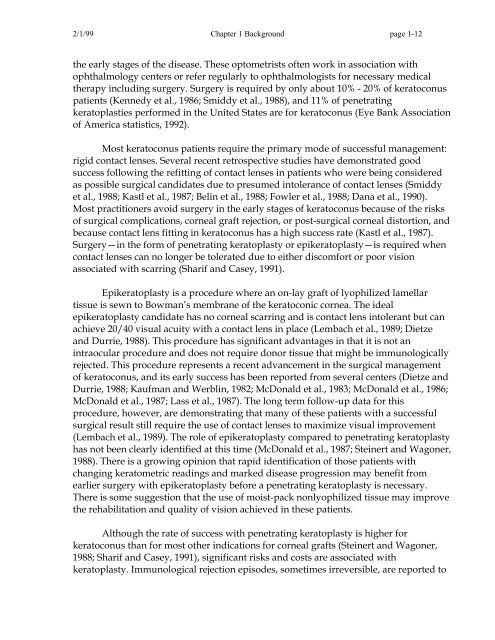OM t of c.iii - Vision Research Coordinating Center - Washington ...
OM t of c.iii - Vision Research Coordinating Center - Washington ...
OM t of c.iii - Vision Research Coordinating Center - Washington ...
Create successful ePaper yourself
Turn your PDF publications into a flip-book with our unique Google optimized e-Paper software.
2/1/99 Chapter 1 Background page 1-12<br />
the early stages <strong>of</strong> the disease. These optometrists <strong>of</strong>ten work in association with<br />
ophthalmology centers or refer regularly to ophthalmologists for necessary medical<br />
therapy including surgery. Surgery is required by only about 10% - 20% <strong>of</strong> keratoconus<br />
patients (Kennedy et al., 1986; Smiddy et al., 1988), and 11% <strong>of</strong> penetrating<br />
keratoplasties performed in the United States are for keratoconus (Eye Bank Association<br />
<strong>of</strong> America statistics, 1992).<br />
Most keratoconus patients require the primary mode <strong>of</strong> successful management:<br />
rigid contact lenses. Several recent retrospective studies have demonstrated good<br />
success following the refitting <strong>of</strong> contact lenses in patients who were being considered<br />
as possible surgical candidates due to presumed intolerance <strong>of</strong> contact lenses (Smiddy<br />
et al., 1988; Kastl et al., 1987; Belin et al., 1988; Fowler et al., 1988; Dana et al., 1990).<br />
Most practitioners avoid surgery in the early stages <strong>of</strong> keratoconus because <strong>of</strong> the risks<br />
<strong>of</strong> surgical complications, corneal graft rejection, or post-surgical corneal distortion, and<br />
because contact lens fitting in keratoconus has a high success rate (Kastl et al., 1987).<br />
Surgery—in the form <strong>of</strong> penetrating keratoplasty or epikeratoplasty—is required when<br />
contact lenses can no longer be tolerated due to either discomfort or poor vision<br />
associated with scarring (Sharif and Casey, 1991).<br />
Epikeratoplasty is a procedure where an on-lay graft <strong>of</strong> lyophilized lamellar<br />
tissue is sewn to Bowman’s membrane <strong>of</strong> the keratoconic cornea. The ideal<br />
epikeratoplasty candidate has no corneal scarring and is contact lens intolerant but can<br />
achieve 20/40 visual acuity with a contact lens in place (Lembach et al., 1989; Dietze<br />
and Durrie, 1988). This procedure has significant advantages in that it is not an<br />
intraocular procedure and does not require donor tissue that might be immunologically<br />
rejected. This procedure represents a recent advancement in the surgical management<br />
<strong>of</strong> keratoconus, and its early success has been reported from several centers (Dietze and<br />
Durrie, 1988; Kaufman and Werblin, 1982; McDonald et al., 1983; McDonald et al., 1986;<br />
McDonald et al., 1987; Lass et al., 1987). The long term follow-up data for this<br />
procedure, however, are demonstrating that many <strong>of</strong> these patients with a successful<br />
surgical result still require the use <strong>of</strong> contact lenses to maximize visual improvement<br />
(Lembach et al., 1989). The role <strong>of</strong> epikeratoplasty compared to penetrating keratoplasty<br />
has not been clearly identified at this time (McDonald et al., 1987; Steinert and Wagoner,<br />
1988). There is a growing opinion that rapid identification <strong>of</strong> those patients with<br />
changing keratometric readings and marked disease progression may benefit from<br />
earlier surgery with epikeratoplasty before a penetrating keratoplasty is necessary.<br />
There is some suggestion that the use <strong>of</strong> moist-pack nonlyophilized tissue may improve<br />
the rehabilitation and quality <strong>of</strong> vision achieved in these patients.<br />
Although the rate <strong>of</strong> success with penetrating keratoplasty is higher for<br />
keratoconus than for most other indications for corneal grafts (Steinert and Wagoner,<br />
1988; Sharif and Casey, 1991), significant risks and costs are associated with<br />
keratoplasty. Immunological rejection episodes, sometimes irreversible, are reported to
















